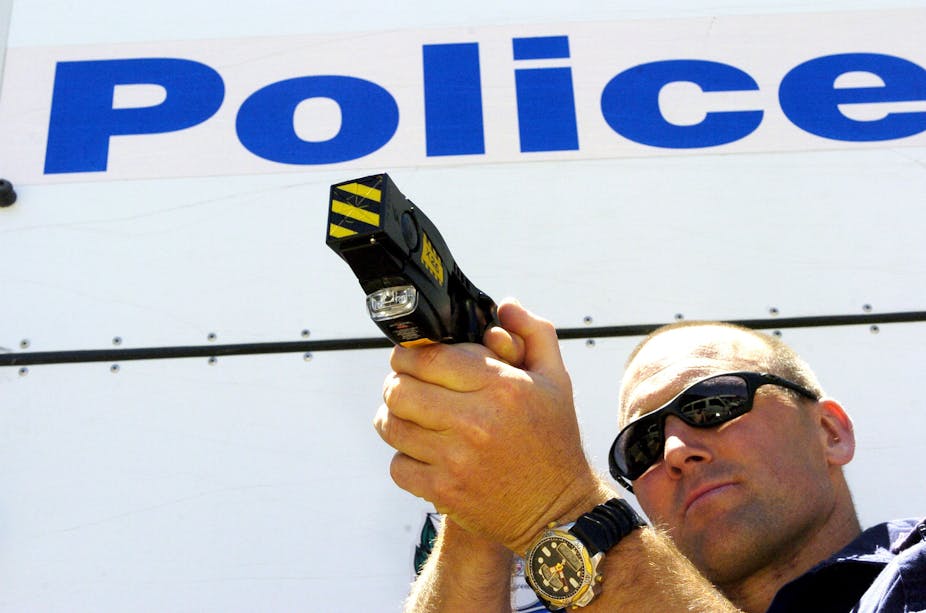The death of 21-year-old Brazilian national, Roberto Laudisio Cruti, on a Sydney street after being tasered by police has ignited questions about the safety and police use of these weapons.
Tasers, the brand name for the electro-shock device used by police, deliver currents of 50,000 volts and are designed to incapacitate. They can be used in “drive stun” mode (hand held) or fired on a wire with barbs at a range of around 6.4 meters.
These devices, like capsicum spray, are part of a category of weapons generically known as less-than-lethal weapons, which were incrementally introduced into Australian policing from the mid-1990s.
Tasers were originally trialed by specialist police but are now standard issue for most forces. Victoria Police recently announced it would join the other states and territories and issue officers with Tasers after what it described as a successful 12-month trial.
Why Tasers?
Calls for the introduction of these weapons inevitably come in the wake of fatal police shootings, when they are promoted as a viable alternative to deadly force. Unlike capsicum spray, Tasers don’t carry a risk of secondary exposure and are seen as being more effective at incapacitating.
Critical voices find little space in the emotional climate after a fatal shooting. Including the Sydney death earlier this week, there have been up to five Taser-related deaths in Australia. In two of these cases – one in Western Australia (2007) and one in the Northern Territory (2009) – Aboriginal men died shortly after being Tasered by police.
The other two cases are less proximate. In a 2002 New South Wales case, a man died two weeks after being Tasered. In another 2009 case, a 16-year-old Queensland boy was run over and killed after police drew a Taser and gun, and told him to lie on the road.
Amnesty Internationl records 500 Taser-related deaths internationally. Inevitably, these figures have been disputed. It is rare for Tasers to be officially listed as the cause of death, which is generally put down to conditions such as heart attack or drug toxicity.
Despite this difficulty, the recent Taser-related death should at least open up space for a better-informed discussion.
Health harms
One critical fact that should frame the debate is the reality that Taser International is a multinational company that reaps enormous profit from the expanding police market for its product. The company is happy to market its weapon as an effective and safe alternative to firearms and deadly force, but it’s uncomfortable about open discussion of safety concerns.
When a medical examiner in the United States found a Taser had contributed to the deaths of a number of people, Taser successfully sued and had the finding overturned. Taser-related, -associated or -proximate deaths have become legally safe but somewhat vague terms describe such deaths.
Taser International, like multinational pharmaceutical companies, is influential enough to raise questions about the independence of the research surrounding the safety of its weapons. It’s clear, however, that there have been no independent tests of the safety of these devices carried out on populations as diverse as police are likely to encounter in the field.
We also know that certain people – pregnant women, those under the influence of drugs, and people in poor health, especially with heart problems – are particularly vulnerable when exposed to shocks from Tasers.
Less than lethal?
Concerns about the potential of Tasers to injure or kill would be of little significance if the devices were used as an alternative to firearms. Whatever the safety concerns, Tasers are, without doubt, less lethal than firearms. But all the evidence suggests that less-than-lethal weapons aren’t used by police as alternatives to deadly force, but are used, instead, in situations firearms would not be justified.
In other words, Tasers are used by police as an addition, rather than as an alternative, to firearms and deadly force.
While Australia doesn’t have nationally consistent police guidelines on the use of Tasers, the tenor of all state and territory guidelines is that these weapons are not to be relied on when a person is armed with a weapon. That is the main circumstance where police are justified in resorting to firearms.
Australian and international evidence shows that as these weapons are normalised into everyday policing, they are increasingly used to gain compliance or, sadly, to simply inflict pain. In 2008, police in Western Australia used a Taser thirteen times in drive stun mode on Aboriginal man Kevin Spratt, even though he was unarmed and already in custody.
One danger with the promise of technological quick fixes such as less-than-lethal weapons is that police stop relying on non weapon-based strategies for diffusing conflict and dealing with challenging situations.
If this continues, it’s likely that the Taser-related death toll will increase in Australia, with no reduction in the incidents of fatal shootings.

